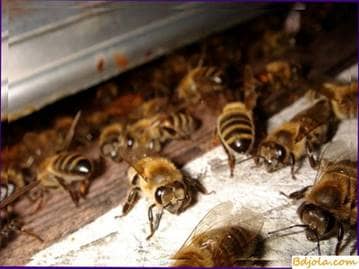
The main conditions of life of bees are air, water, food and heat.
The need for air in bees is great. A huge amount of bee brood requires a rapid change in the exhaust air.
Excessive stuffiness and depravity of air are harmful to them. Therefore, bees in the summer tend to intensified ventilation, or ventilation, their nest.
This is done in this way: the bees stand at the tap hole, at the bottom of the hive, on its walls and on the honeycombs in groups and strenuously wiggle their wings in one direction, resulting in incoming and outgoing air currents, and a sound resembling a murmur.
Bulling of bees on the front wall indicates a lack of ventilation. This is usually observed in hot days. Strong families create stuffiness and part of the bees goes outside. Therefore, in hot season it is necessary to increase ventilation by expanding the tapholes, opening the upper tapholes, removing all the pillows, with the exception of the canvas, and setting up the extensions.
Золотистый щурок. Пчелы корм.
The bee family and its composition